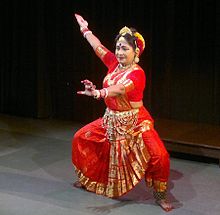ಗೌಡೀಯನೃತ್ಯಂ
ಗೋಚರ
ಗೌಡೀಯನೃತ್ಯಂ
[ಬದಲಾಯಿಸಿ]
ಗೌಡೀಯನೃತ್ಯಂ ( ಬಾಂಗ್ಲಾ: গৌড়ীয় নৃত্য, ಅ.ಸಂ.ಲಿ.ವ.: Gaur̤īẏa Nṛtya ) ಅಥವಾ Gôur̤īyo Nrityô, ಇದು ಶಾಸ್ತ್ರೀಯ ಬಂಗಾಳಿ ನೃತ್ಯ ಸಂಪ್ರದಾಯವಾಗಿದೆ.[೧] [೨] [೩] ಇದು ಬಂಗಾಳದಲ್ಲಿ ಗೌರ್ ಎಂದು ಕರೆಯಲ್ಪಡುವ ಗೌಡನಿಂದ ಹುಟ್ಟಿಕೊಂಡಿದೆ. [೪]
ಇದನ್ನು ಮಹುಆ ಮುಖೋಪಾಧ್ಯಾಯ್ಯವರು ಪುನರ್ನಿರ್ಮಿಸಿದ್ದಾರೆ.[೩] [೫] ಇದನ್ನು ಸಂಸ್ಕೃತಿ ಸಚಿವಾಲಯವು ಭಾರತೀಯ ಶಾಸ್ತ್ರೀಯ ನೃತ್ಯವೆಂದು ಗುರುತಿಸಿದೆ, [೬] ಸಂಗೀತ ನಾಟಕ ಅಕಾಡೆಮಿಯಿಂದ ಗುರುತಿಸಲಾಗಿಲ್ಲ, ಆದರೆ ಅದರ ಅಧ್ಯಯನವು ಭಾರತದ ಸಂಸ್ಕೃತಿ ಸಚಿವಾಲಯದಿಂದ ವಿದ್ಯಾರ್ಥಿವೇತನಕ್ಕೆ ಅರ್ಹವಾಗಿದೆ. [೭] ಪುನರ್ನಿರ್ಮಾಣದ ಪಾಂಡಿತ್ಯಪೂರ್ಣ ಸ್ವಾಗತವು ಎಚ್ಚರಿಕೆಯಿಂದ ಸಂದೇಹವಾದದವರೆಗೆ ಇರುತ್ತದೆ.[೮] [೯] [೧೦]
ಉಲ್ಲೇಖಗಳು
[ಬದಲಾಯಿಸಿ]- ↑ Roma Chatterji (2005). Folklore and the Construction of National Tradition Archived 2018-02-12 ವೇಬ್ಯಾಕ್ ಮೆಷಿನ್ ನಲ್ಲಿ.. Indian Folklife 19 (Folklore Abroad: On the Diffusion and Revision of Sociocultural Categories): 9. Accessed January 2014. "a classical dance tradition that has vanished from the urban areas".
- ↑ "West Bengal Tourism: Dance". Department of Tourism, Government of West Bengal. 2011. Archived from the original on October 21, 2013. Retrieved January 11, 2014.
- ↑ ೩.೦ ೩.೧ Bharatram, Kumudha (April 9, 2011). "Dance of the ancients". The Hindu. Retrieved November 15, 2013.
- ↑ Mukherjee, Mahua (2000). Gaudiya Nritya (in Bengali). Kolkata: The Asiatic Society.
- ↑ Rajan, Anjana (December 26, 2006). "The wheel has come full circle". The Hindu. Archived from the original on November 8, 2012.
- ↑ "Gaudiya Nritya". INDIAN CULTURE (in ಇಂಗ್ಲಿಷ್). Retrieved 2022-01-25."Gaudiya Nritya". INDIAN CULTURE. Retrieved January 25, 2022.
- ↑ "Scholarship to Young Artistes, 2005". Ministry of Culture. Government of India. Archived from the original on ಅಕ್ಟೋಬರ್ 21, 2013. Retrieved ಸೆಪ್ಟೆಂಬರ್ 24, 2022.
{{cite web}}: CS1 maint: bot: original URL status unknown (link). Ministry of Culture. Government of India. Archived from the original on October 21, 2013. - ↑ "Feet forgotten and found". www.telegraphindia.com. Retrieved 2022-01-25.
- ↑ Leela Venkataraman (2006). Negotiating the Extremes: dance. India International Centre Quarterly, 33 (1): 93-102. (subscription required) "one may have reservations about the classical dance repertoire visualised by [Mukherjee]".
- ↑ Roma Chatterji (2005). p. 9: "Mukherjee tries to reconstitute a Bengali aesthetic within the perspective of pan-Indian civilisation".
